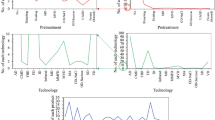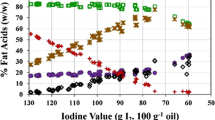Abstract
This work develops a hybridized support vector regression (HSVR)-based model for accurate estimation of melting points of fatty acids using their molecular weights and the number of carbon–carbon double bond as descriptors. The development of HSVR-based model is characterized with two stages. The first stage involves training and testing SVR using test-set-cross validation technique with molecular weights and the number of carbon–carbon double bond as descriptors, while the second stage utilizes the estimated melting points obtained from the first stage as descriptor for further training and testing of SVR. The proposed hybrid system therefore demonstrates a better predictive and generalization ability than ordinary SVR. Furthermore, the melting points of sixty-two fatty acids estimated using the proposed HSVR-based model show persistence closeness with the experimental values than the results of other existing predictive models for fatty acids melting points estimation such as Guijie et al. model and Guendouzi model. The developed HSVR-based model is also characterized with higher value of coefficient of correlation and lower value of mean absolute error than that of the existing predictive models. Superiority of the developed HSVR-based model over the existing predictive models in terms of the ease of obtaining its descriptors and the accuracy of its estimates is advantageous to unravel estimation challenges associated with determination of fatty acids melting points.









Similar content being viewed by others
Explore related subjects
Discover the latest articles, news and stories from top researchers in related subjects.References
Rustan AC (2005) Fatty acids: structures and properties
Haast RAM, Kiliaan AJ (2015) Prostaglandins, Leukotrienes and essential fatty acids impact of fatty acids on brain circulation, structure and function. Prostaglandins Leukot Essent Fat Acids 92:3–14
Hariri M, Ghiasvand R, Shiranian A, Askari G, Iraj B, Salehi-Abargouei A (2014) Does omega-3 fatty acids supplementation affect circulating leptin levels? a systematic review and meta-analysis on randomized controlled clinical trials. Clin Endocrinol (Oxf) 2015:221–228
Liang G, Xu J, Liu L (2013) QSPR analysis for melting point of fatty acids using genetic algorithm based multiple linear regression (GA-MLR). Fluid Phase Equilib 353(2013):15–21
Guendouzi A, Mekelleche SM (2012) Prediction of the melting points of fatty acids from computed molecular descriptors: a quantitative structure-property relationship study. Chem Phys Lipids 165(1):1–6
Robert O (2009) A comprehensive evaluation of the melting points of fatty acids and esters determined by differential scanning calorimetry. J Am Oil Chem Soc 89(9):843
Fasina OO, Craig-Schmidt M, Colley Z, Hallman H (2008) Predicting melting characteristics of vegetable oils from fatty acid composition. LWT: Food Sci Technol 41(8):1501–1505
Xu J, Zhang H, Wang L, Ye W, Xu W, Li Z (2010) QSPR analysis of infinite dilution activity coefficients of chlorinated organic compounds in water. Fluid Phase Equilib 291(2):111–116
Xu J, Guo B, Chen B, Zhang Q (2005) A QSPR treatment for the thermal stabilities of second-order NLO chromophore molecules. J Mol Model 12(1):65–75
Steffen C, Thomas K, Huniar U, Hellweg A, Rubner O, Schroer A (2010) TmoleX: a graphical user interface for TURBOMOLE. J Comput Chem 31(16):2967–2970
Katritzky AR, Maran U, Karelson M, Lobanov VS (1997) Prediction of melting points for the substituted benzenes: a QSPR approach. J Chem Inf Model 37(5):913–919
Katritzky AR, Jain R, Lomaka A, Petrukhin R, Maran U, Karelson M (2001) Perspective on the relationship between melting points and chemical structure. Cryst Growth Des 1(4):261–265
Gu G, Zhu J, Liu Z (2015) Visual saliency detection based object recognition. J Inf Hiding Multimed Signal Process 6:1250–1263
Lin T, Huang H, Liao B, Pan J (2007) An optimized approach on applying genetic algorithm to adaptive cluster validity index. Int J Comput Sci Eng Syst 2:253–258
Chang F-C, Hang H-M, Huang H-C (2003) Research friendly MPEG-7 software testbed,” In: Proceedings of the IS&T/SPIE symposium on electronic imaging science and technology 2003, vol 5022, pp 890–901
Xiong T (2015) Robust Gaussian mixture modelling based on spatially constraints for image segmentation. J Inf Hiding Multimed Signal Process 6:857–868
Owolabi TO, Akande KO, Olatunji SO (2016) Application of computational intelligence technique for estimating superconducting transition temperature of YBCO superconductors. Appl Soft Comput 43:143–149
Adewumi AA, Owolabi TO, Alade IO, Olatunji SO (2016) Estimation of physical, mechanical and hydrological properties of permeable concrete using computational intelligence approach. Appl Soft Comput 42:342–350
Owolabi TO, Akande KO, Olatunji SO (2015) Estimation of superconducting transition temperature T C for superconductors of the doped MgB2 system from the crystal lattice parameters using support vector regression. J Supercond Nov Magn 28:75–81
Owolabi TO, Akande KO, Olatunji SO (2015) Development and validation of surface energies estimator (SEE) using computational intelligence technique. Comput Mater Sci 101:143–151
Owolabi TO, Akande KO, Olatunji SO (2015) Estimation of surface energies of hexagonal close packed metals using computational intelligence technique. Appl Soft Comput 31:360–368
Owolabi TO, Akande KO, Sunday OO (2015) Modeling of average surface energy estimator using computational intelligence technique. Multidiscip Model Mater Struct 11(2):284–296
Cai CZ, Wang GL, Wen YF, Pei JF, Zhu XJ, Zhuang WP (2010) Superconducting transition temperature T C estimation for superconductors of the doped MgB2 system using topological index via support vector regression. J Supercond Nov Magn 23(5):745–748
Cai CZ, Xiao TT, Tang JL, Huang SJ (2013) Analysis of process parameters in the laser deposition of YBa2Cu3O7 superconducting films by using SVR. Phys C Supercond 493:100–103
Majid A, Khan A, Javed G, Mirza AM (2010) Lattice constant prediction of cubic and monoclinic perovskites using neural networks and support vector regression. Comput Mater Sci 50(2):363–372
Cui Y, Dy JG, Alexander B, Jiang SB (2008) Fluoroscopic gating without implanted fiducial markers for lung cancer radiotherapy based on support vector machines. Phys Med Biol 53(16):N315–N327
Shini MA, Laufer S, Rubinsky B (2011) SVM for prostate cancer using electrical impedance measurements. Inst Phys 32(9):1373–1387
Akande KO, Owolabi TO, Olatunji SO (2015) Investigating the effect of correlation-based feature selection on the performance of support vector machines in reservoir characterization. J Nat Gas Sci Eng 22:515–522
Owolabi TO, Gondal MA (2015) Estimation of surface tension of methyl esters biodiesels using computational intelligence technique. Appl Soft Comput 37:227–233
Cortes C, Vapnik V (1995) Support vector networks. Mach Learn 20:273–297
Vapnik V (1995) The nature of statistical learning theory. Springer, Berlin
Basak D, And SP, Partababis DC (2007) Support vector regression. Neural Inf Process 11:203
Lide DR (2003) CRC handbook of chemistry and physics. CRC Press, Boca Raton
Author information
Authors and Affiliations
Corresponding author
Appendix
Appendix
See Table 5.
Rights and permissions
About this article
Cite this article
Owolabi, T.O., Zakariya, Y.F., Olatunji, S.O. et al. Estimation of melting points of fatty acids using homogeneously hybridized support vector regression. Neural Comput & Applic 28 (Suppl 1), 275–287 (2017). https://doi.org/10.1007/s00521-016-2344-2
Received:
Accepted:
Published:
Issue Date:
DOI: https://doi.org/10.1007/s00521-016-2344-2




